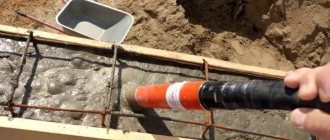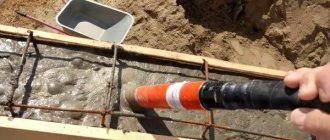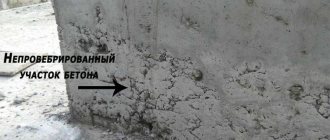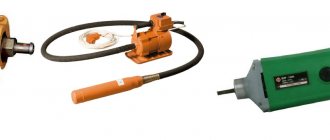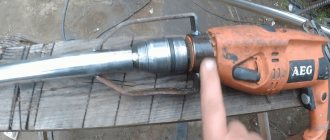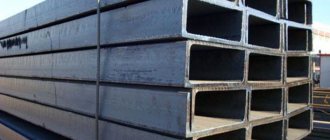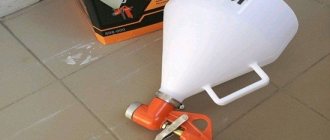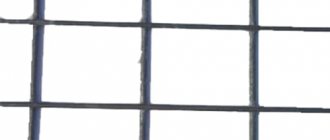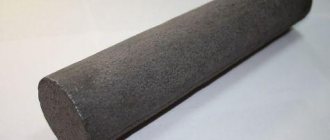Beton-House.com
Website about concrete: construction, characteristics, design. We combine the experience of professionals and private craftsmen in one place
Deep vibrator at work
In life we often encounter the need to carry out work on constructing concrete and reinforced concrete structures. Typically, concrete is used in the manufacture of products and buildings with a long service life.
To improve their performance characteristics and durability, a deep vibrator is needed. There are quite a lot of models on the market with different characteristics, however, if you wish, you can make an internal vibrator for concrete with your own hands.
What's happened?
So, an internal vibrator is an important tool for a construction worker. Basically, it has an electric drive, which makes it light and easy to carry. Two people are involved in working with a deep vibrator.
One holds the drive itself, the other lowers the main mechanism of the tool into the concrete. If we consider the design of a typical vibrator, it always consists of a drive, a flexible tip and an immersed part in the form of a flexible shaft. The operating principle of the device is simple.
Voltage is supplied to the drive motor, which provides torque to the flexible shaft, at the end of which there is an eccentric. The eccentric rotates, hits the walls of the submersible tip body, creating a vibration that destroys the voids inside the poured concrete, which leads to air escaping to the surface.
Concrete vibration process
to use a 220V deep vibrator in your work, especially in the corners, since this is where cracks often form. In addition, the vibrator assumes the formation of a smooth concrete surface, uniform settling of the filler, which is gravel, quartzite, granite, expanded clay and other filling options.
This allows the contents to be evenly distributed throughout the foundation structure, which increases the ability to withstand heavy loads. I would like to note that such a tool is rarely used to process the surface of the base. In this case, a vibrating screed is used. It is laid on the concrete surface and specialists stretch it across the entire area. Due to vibration, the surface is leveled and becomes smooth.
Purpose
Even a solution thoroughly swirled in a stirrer cannot be 100% homogeneous. In theory, an uncured monolith is a “skeleton” of crushed stone, evenly covered with a wet cement-sand mixture. In reality, the contents of the formwork (form) include:
RECOMMENDED ON THE TOPIC
- Penetrating waterproofing for concrete
- How to choose impregnation for concrete
- air bubbles;
- water unbound with cement;
- undistributed aggregate or additive particles.
The risk of stratification and airing of the mortar increases with a long time interval between mixing and installation, incorrect pouring (from a great height or in thick layers) or transportation.
Liquid and air “pockets” impair the adhesion of the crushed stone frame to the binder. Having gained strength, uncompacted concrete quickly cracks and crumbles.
To achieve uniformity when pouring into formwork, the concrete solution must be fluid (plastic). At the same time, the correct proportions of heavy concrete exclude a consistency convenient for laying. The use of a deep vibrator for pouring concrete can temporarily increase the fluidity of concrete and prevent the mixture from separating.
After the “correct” vibration compaction:
- the volume of concrete poured into the formwork is reduced by a third - due to the removal of gas and liquid sinks, compaction of sand and crushed stone;
- Cement laitance and fine sand fractions float to the top, the surface becomes smooth and glossy.
During hardening, the “vibrated” monolith reaches high density and maximum (for the design grade) strength.
Description and characteristics
The deep vibrator is generally light and has small dimensions, but it is better for two people to work with it. As we said earlier, the first worker will hold the tool itself and bring it to the desired place, and the second will pierce the concrete base using a submersible flexible shaft. As for selection issues, it is important to determine the characteristics of the tool, since they are fundamental. I would like to highlight the following characteristics:
1. Engine power. Each drive has a motor inside it. Here they divide models into household and professional. For models for domestic use, the power should not exceed one and a half kW. At the same time, less than 0.75 kW will also not be enough for domestic needs. For industrial operating conditions, a heavier and more powerful vibrator is required, with a power limit of 3 to 4 kW, inclusive.
2. Flexible shaft. It must have a length that will be greater than the size of the formwork, taking into account the depth of the foundation. Take the tool with a reserve. If your foundation has a depth of about 1 m, plus formwork, then you need to choose a flexible shaft length of at least 2 m.
From this point of view, it is convenient to rent a deep vibrator from those who have many different varieties. The vibrator is often used in layers. This is due to the fact that the depth tip can be of a fixed, small size. At the same time, when immersed in concrete, it should stick out slightly above the surface. Thus, another selection criterion is the length of the tip.
3. Tip diameter. This criterion is no less important. The tip is also called a mace. If we work with a larger diameter, we can process a larger volume of concrete in a short period of time. It is worth considering that during one immersion during vibration, no more than 10-12 cm in diameter is processed around even the thickest tip.
Therefore, even the thickest tip should be reusable over the entire base area. The work is difficult and requires a lot of effort, but you can guarantee the quality of the foundation.
4. Frequency of eccentric oscillations. This criterion even depends directly on the type of concrete you will use. Any concrete has a concept of grain size. This is due to the quality of the filler and the fraction used. Therefore, if you use coarse-grained concrete, it is better to use a low-frequency tool in your work, where the vibration value does not exceed 3500 in one minute.
As for high-frequency tools, they will work best with fine-grained concrete. If you are buying a tool for your home, it is best to pay attention to models with intermediate vibration values. This will help ensure that air is removed from the monolith or tape-type base.
5. Weight of the product. We said earlier that the weight is light. This applies to average models for household use. But, if we are talking about a professional tool, then its weight can reach 100 kg. This vibrator is equipped with a transportation system, and it must be rolled along the poured base. It must be emphasized that household tools weigh no more than 6-8 kg.
Operating principle
In formwork with reinforcement filled with concrete, it is problematic to mix the solution manually. Using a steel rod to “bayonet” a concrete mass does not bring the desired effect. There is a need to use a device that transmits high-frequency vibrations to the solution.
To remove air and improve the connection between concrete particles - these are the tasks that a construction vibrator performs
Based on the principle of impact on concrete mortar, devices are divided into types:
- Submersible-type vibration compactors (deep), which transmit high-frequency vibrations to the concrete mass through the body of the submersible nozzle.
- External platform-type devices placed on the formwork that transmit vibration to the concrete mass.
- Surface devices, the vibration from which is transmitted to a specific work area where the concrete solution is laid.
A submersible device that creates high-frequency oscillations in the thickness of the massif is widely used.
The operating feature of the vibrating compactor, which implements this principle, is based on the removal of air bubbles from the concrete solution. A high-frequency vibrator transmits vibration energy to the concrete through the working element, mixing it. Lighter air bubbles tend to rise outward. This increases the moisture resistance of the monolith, relieves internal stress, and reduces the likelihood of shell formation.
Kinds
As for the varieties, here the vibrator is represented by four main modifications. This concerns the principle of operation of the device, where electric type vibrators are most often found. They are easy to use, weigh less, but at the same time develop the required amount of eccentric vibrations.
In the electric modification, an important link is the electric motor, the power of which varies up to 4 kW, depending on whether the model is amateur or professional. Another type is pneumatic. It is not used for domestic needs, since this type of design and method of operation of the device requires the presence of an additional installation that will create air pressure.
The device is difficult to use, but has a fairly high efficiency. Diesel and gasoline vibrators are two more varieties on sale. These devices are autonomous, although they are the heaviest among the electrically driven varieties. Diesel engines are even cheaper, since they consume less fuel, and it costs a little less than the cost of gasoline.
Scope of application
They use a high-frequency deep vibrator in construction matters. For example, if you are going to build a private house, then you will need it. Having dug the foundation and prepared the concrete for pouring, they begin to fill the base. At the same time, every 20 cm of depth, the base must be passed through with a deep vibrator, at least every 30 cm. These will be so-called punctures, which will remove excess air.
Not only the strip base, but also the monolithic base is subjected to similar treatment. Some even “thick” floor screeds are processed using a deep vibrator, but the latter is much more convenient to do in combination with a vibrating screed. The scope of application covers private and capital construction, so any construction team must have such a tool.
DIY vibrator
The simplest deep concrete vibrator is made on the basis of a hammer drill. This is a ready-made tool that contains a button, an electric motor, and the ability to connect various attachments. As a nozzle we will use homemade products based on a round metal rod with a diameter of 8 mm.
But in order for it to fit normally into the hammer drill, it is necessary that its end be chambered for the SDS+ cartridge. Therefore, we buy absolutely any nozzle with such an ending, cut it off, and weld it to our rod. In this case, the length of the drive must be at least 1 m.
DIY deep vibrator from a drill
Let's go to the store and buy a plastic pipe for the water supply. You can take the cheapest pipe, with a diameter of 32mm. This is the outside diameter, so take a caliper and measure the diameter of the pipe from the inside. Next, we buy 3 bearings based on this diameter.
Taking into account that the internal diameter must match the diameter of our rod, which is 8 mm. If you have something on hand in slightly different sizes, you can use that too, as long as everything matches. It is necessary to place our 3 bearings on the shaft at equal intervals.
They should sit firmly and not move along the length. An eccentric must be welded onto the end of the shaft. That is, on one side it is necessary to weld a small plate, which, when rotated, will create vibrations inside the pipe. Next, we put our shaft with bearings installed on it onto a plastic pipe.
If you were unable to select the exact diameter of the bearings and there are gaps, you can use electrical tape, which you wrap over the bearing to seal it. As they say, yellow electrical tape will help in all matters. For additional compaction, you can bend the shaft slightly.
After you have inserted the shaft with bearings into the pipe, we put it on our hammer drill and turn on the vibration device. When you turn it on, you will notice that vibration occurs inside the pipe. The tip moves, creates vibrations, and the pipe itself also vibrates a little.
Thus, we will create the required amount of vibration and a do-it-yourself deep vibrator will solve our problems with pouring the foundation. Not much money will be spent on this, so if you have a hammer drill, the budget will remain the same. Assembly takes about 3 hours if you have the parts on hand.
Vibrating plate assembly algorithm
To make your own vibrating plate for soil compaction, you will need the following materials and parts:
- steel sheet measuring 50 by 80 cm with a thickness of at least 8 mm;
- an area vibrator with an electric motor, for example, IV-98E;
- 2 pieces of channel 45 cm long;
- fastening: M10 and M12 bolts with nuts, washers;
- shock absorbers;
- 1.5 m metal pipe (diameter 20-25 mm).
Tools you will need:
- welding machine;
- hammer;
- grinder with cutting wheels;
- electric drill with a set of metal drills;
- spanners;
- tape measure, marker or chalk.
A homemade vibrating plate with an electric motor is assembled in the following sequence.
- Using a grinder, make cuts about 5 mm deep (so that the metal can be bent) at both ends of the steel sheet. 10 cm depart from the front edge, and 5 cm from the rear edge.
- The edges are bent at an angle of approximately 20-30 degrees with a hammer, after which the bend is welded.
- Two channels are welded parallel to the curved edges at a distance of approximately 5-10 cm from the center line of the workpiece made.
- A vibrator is installed in the center, along the legs of which marks are made for fasteners.
- Drill holes in the channels using an electric drill.
- Mount the vibrator, attaching it with bolts, nuts and washers.
- Shock-absorbing cushions are attached to the slab.
- Bend the tube into a U-shape to make a handle.
- Holes are drilled at the edges for bolt fastening.
- The handle is attached to the sole through metal corners and shock absorbers.
- Connect the power cable and install the start-up protection equipment.
- Check the functionality of the created unit.
The mass of the assembled vibrating plate will be approximately 60 kg. To make it convenient to transport, a piece of pipe is welded to the plate, which will serve as an axle for the wheels.
A more complex option for creating a vibrating plate involves using a separate engine, for example, from a walk-behind tractor. In this case, to assemble vibration equipment, you will need a homemade or factory vibrator. The rotation of the motor will be transmitted to it using a belt placed on pulleys.
The entire process of assembling the vibrating plate is shown in the photo below.
After painting, the final mechanism will look like the photo below.
If necessary, you can increase the mass of a homemade vibrating plate. This is done by additional welding of metal sheets or reinforcement rods. A vibrating tool created with your own hands is quite capable of competing with factory-made analogues.
Is it profitable to rent a vibrator?
If you work in a construction team and are constantly involved with the construction of the foundation, then, of course, spending money on rent is not profitable for you. It’s better to invest once and purchase tools of proper quality. If you are a private person and are pouring a foundation, where work is usually completed within one day, then renting a deep vibrator is simply necessary for you.
There is no point in buying a tool that will then sit on your shelf and remain idle. Renting such an instrument is inexpensive, usually 400-800 rubles. in one day, so you can easily afford it.
At the same time, you will receive a guaranteed working tool, which you will then return and will not clutter up your own shelves in the garage. By the way, this is convenient in the early stages, since when construction begins there is simply no place where you could store it all. They brought it, worked, and returned it.
Price
If you are ready to buy this instrument as your own, then pay attention to the price segments of the domestic market. There are both cheap and expensive models, which differ fundamentally in their operating properties. , the red lighthouse deep vibrator has proven itself well .
In the price range for a deep-well vibrator up to 15,000 rubles, you can purchase a tool quite suitable for the job, with a shaft length of up to 3 m, and a power of 1300 W. This is a household tool that is suitable for pouring small strip foundations, floors, and other work with a light load. The vibration frequency is 3600 units per minute.
Club length 410 mm. The EPK-1300 deep vibrator fits the description . The wacker deep vibrator is expensive, but it is very professional. This is a simple and convenient submersible tool, which is available in modifications at a cost of up to 70,000 rubles.
It is quite powerful, so immediately buy a high-quality carrying case for it, since for Wacker Neuson IEC 45 models the current consumption is at least 4 amperes. The power here is 560 W, but despite this, it is highly efficient, thanks to the correct design. Flexible shaft included. The diameter of the club in this model is 45 mm.
No one has canceled the savings, so there are modifications on sale that cost no more than 2,000 rubles. Consider for yourself how good their construction is and how they will perform the job. Perhaps they will be enough for one time for your own home.
Flexible shaft of deep vibrator
The flexible shaft of the deep vibrator can be purchased separately. Often it comes standard with a tool, but you can purchase the right model for specific tasks. Its price is low, for example, for 1,500 rubles you can buy GROST VG 1.2/35.
Moreover, its length will be 1.2 m, diameter 35 mm, and weight about 3.5 kg. By the way, such an attachment can be purchased for a homemade device, which will save a lot of money. The option for deep work is considered to be model TDX 6 020515.
The device of the tip of the deep vibrator
It costs about 7,000 rubles. It should be used provided that it was not possible to process each layer step by step. The weight of this product is 8 kg. You should pay attention to the compatibility of this flexible shaft with a specific vibrator model.
Vibrating screed assembly algorithm
To implement the simplest options, drawings are not needed. Suitable drive units:
- Sander;
- Bulgarian;
electric drill or screwdriver.
You will also need the following working tools and materials:
- a flat, polished board 0.5 m long, about 3 cm thick, 25 cm wide;
- self-tapping screws;
- punched paper tape;
- timber 5 by 5 cm long 1-1.5 (2 pcs) to make a handle.
A vibrating screed made from an electric drill in the form of a mop is assembled in the following sequence:
- the surface of the board (if it is not sanded) is made smooth using a plane and sandpaper;
- to it from above exactly in the center, using punched tape and self-tapping screws, fix an electric drill laid lengthwise;
- on both sides of the drill, stepping back a few centimeters, attach the handles at an angle, having previously cut off the ends of the bars obliquely;
- fix in the power tool chuck an attachment whose center of gravity is shifted, for example, a clamping wrench, a curved drill or a piece of reinforcement;
- connect the unit to the network and check its performance.
The drill chuck should rotate around an axis that coincides with the central longitudinal line of the board. Vibration occurs due to the use of a nozzle with a displaced center of gravity.
A vibrating lathe from a grinder, grinder or screwdriver is made in a similar way. Only after compacting and leveling the concrete will the power tool need to be thoroughly cleaned of the mortar so that it can be used in the future.
If you need to compact and level concrete with a layer of up to 10 cm, then a vibrating screed made from an in-depth vibrator is suitable. It is made as follows:
- cut out a rectangular sheet from plywood (with a side length of approximately 70x50 cm);
- The mace is attached to it using punched tape or using clamps, while the deep vibrator itself serves as a kind of handle.
To ensure that the rail moves freely, it is better to cover the working surface of the plywood rectangle with tin, bent at the edges.
Which manufacturer should you choose?
When choosing a manufacturer, you should pay attention to reviews. You need to communicate with those who have already purchased a similar item, and also control your own expenses. Moreover, if you plan to pour your own foundation, there is no point in overpaying for the manufacturer.
For example, in this case, a portable vibrator from Zitrek is suitable. Zitrek Z-900 r will operate from a household network of 220 volts, have small dimensions, have a flexible shaft of 2 m and a mace of about 35 mm in diameter. It is considered effective, convenient for home use and is suitable at all stages of foundation arrangement.
We need a semi-professional model. Please pay attention to the supplier “Industrialist”. For example, the Industrialist EP220 GV22651 has a shaft of 6 m, a mace with a diameter of 51 mm. It operates from a 220 volt network, has a cable length of 5 m, and consumes about 8.5 amperes.
Therefore, get a carrier of the proper cross-section for it. The entire model range from is characterized by a bright shade of red. Let's not forget about the company Red Lighthouse and wacker, who supply some of the best options for deep-seated vibrators today.
Warranty service
The factories provide a warranty for portable construction equipment and its components for 1 (one) year, provided that the technical requirements for its care are met.
In the event that equipment malfunction occurs as a result of incorrect actions by the consumer, the plant is not responsible for it. For example: the rupture of a sleeve due to the hardening of “concrete milk” in its cavity indicates that the client did not clean the flexible shaft after completing the concrete compaction work. For this reason, the manufacturer is not responsible for this type of breakdown.
For industrial multi-station devices (gasoline, diesel, high-frequency and electric vibrators) and spare parts for them, the plant issues a warranty for a period of 1000 hours of operation over 1 calendar year.
But in cases where:
- the storage conditions of the device were not met (damp room, moving parts of mechanisms not cleaned and lubricated, bending of the flexible shaft not permitted...);
- the mace overheated due to working in a waterless environment;
- the motor failed due to low voltage in the supply network;
- the mace was operated in a state clamped between reinforcing bars;
- there was no lubrication of the flexible shaft cable and the drive and mace bearings,
and the device fails, the manufacturer does not provide free restoration of construction equipment to the consumer.
